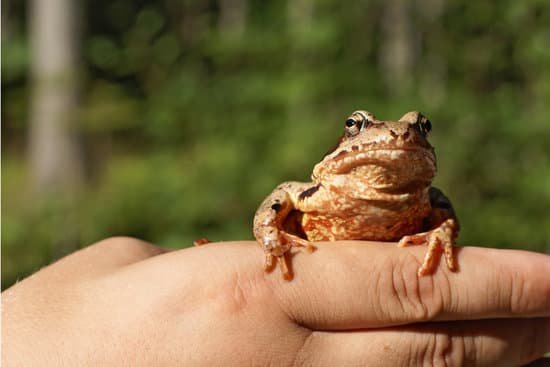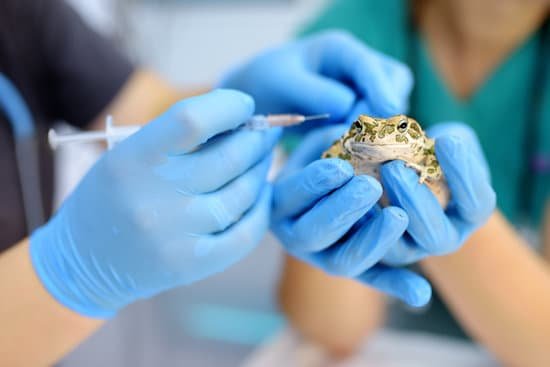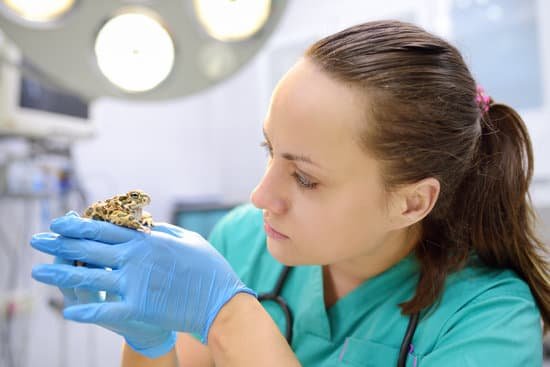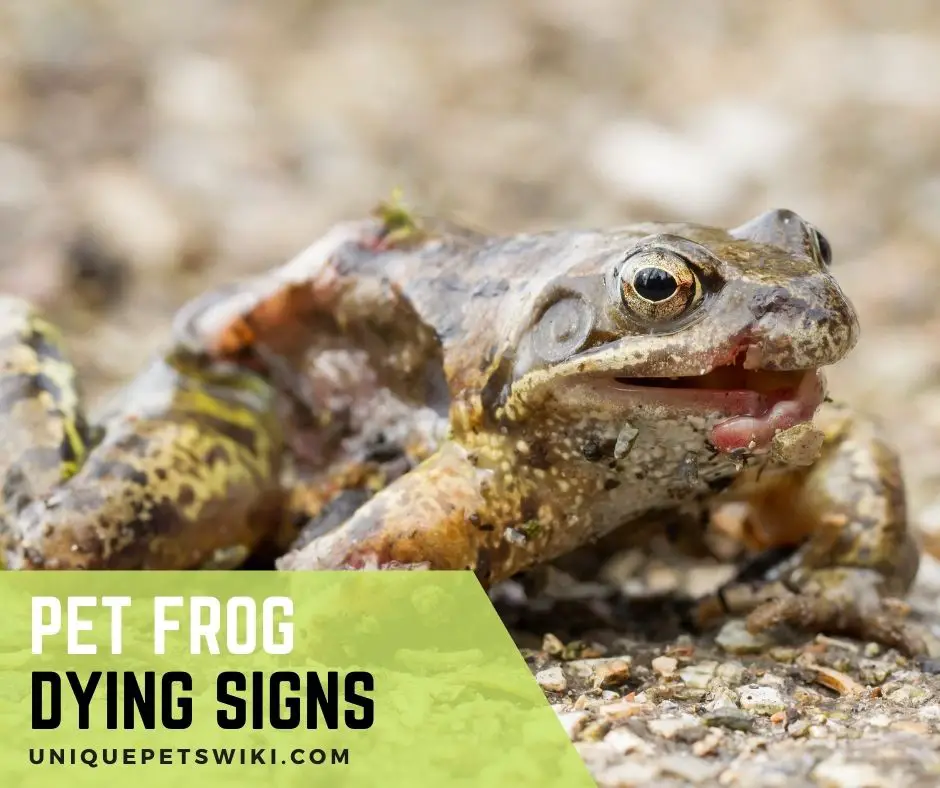I have a friend who once whispered, “I love pets, especially the small and not too difficult to care for kind of pets. But I’m not sure I’ll always be available to handle them”.
If you’re like my friend Audrey, needlessly worrying about having time to bond with your pet, then, pet frogs are ideal for you. But before you get too excited, these frogs get sick just like other animals would.
Why they get sick, how can you can tell in time that your frog is sick, and what to do when you find out that your frog is sick; is what this article will talk about.
Every symptom in captive frogs (of all species) will be discussed with the goal to keep you in the know-how regarding how to treat your pet when the need arises. Isn’t this interesting, to be able to detect and treat your pet when it gets sick?
Let’s delve into the topic in detail.
This article has been reviewed by Dr. Gospel. Read more about our knowledge control process here.
Contents
- 15 Signs Of A Dying Frog (Pet Frog)
- How To Tell If Your Frog Is Sick?
- 15 Signs Of A Sick Frog
- Acting Lethargic
- Unable To Hop Or Move Properly
- Loss Of Appetite
- Sudden And Extreme Color Change
- Weight Loss (Looking Thin)
- Lumps, Holes, Or Cuts In The Skin
- Unable To Right Itself If Placed On Its Back
- Reddened Belly And Legs
- Blisters Or Sores
- Absence Of Poops
- Bloating Or Swollen Body
- Black Patches On The Legs And Backs, Blotches, Freckles, And Pale Spots
- Cloudy Eyes Or Blood In The Eye
- Can You Treat A Sick Frog?
- Ill Symptoms That You Can Treat At Home
- When Do You Need A Vet For Your Frog?
- How To Help Prevent Sickness In Captive Frog?
- Wrapping Up
15 Signs Of A Dying Frog (Pet Frog)

Whichever frog species you’re keeping, signs that it is sick and may die include:
- Unable to hop or move properly.
- Acting lethargic.
- Loss of appetite.
- Sudden and extreme color change.
- Abscesses and lesions.
- Lumps, holes, or cuts in the skin.
- Unable to right itself if placed on its back.
- Swollen body.
- Reddened belly and legs.
- Blisters or sores.
It’s possible to keep an exotic animal at home as a pet without it getting sick. That will happen if you know what you’re doing in terms of giving it optimal care and habitat.
This is because what often causes illness to them is poor husbandry. Poor husbandry in the area of dieting, cage set up, temperature, and humidity requirements. For aquatic frog species, poor water quality can cause ill health.
You don’t get a pet and then research how to care for that pet. You’re likely going to lose that pet this way. It’s always recommended that you do detailed research on the specific requirements of the animal’s needs before getting it home.
This will include looking for an available veterinarian in case trouble arises. Early detection and treatment are important to rescue your frog from death.
How To Tell If Your Frog Is Sick?

Telling whether your frog is sick shouldn’t be a herculean task if you know what to look for on a regular basis. To be able to do this, pay close attention to changes in its behavior and appearance.
There are several signs to tell your pet frog is dying, including behavior changes such as breathing problems, decreased activity level, no poops, blisters or cuts on the body, abnormal body-color, constant soaking or weight loss.
Besides this, if your frog looks malnourished or skinny, it’s likely a problem with its diet.
Weight loss as a result of other diseases can also make your frog look skinny. To determine what is the cause of its skinny appearance, evaluate your husbandry to know if the problem is with its diet or not.
If you suspect any disease, take your frog to the veterinarian for proper diagnosis and treatment.
Also, pay attention to fungal and parasitic infections such as reddening of the skin at the side of the frog’s legs and belly. This disease is considered a fatal illness and can kill the frog if not treated in time.
15 Signs Of A Sick Frog

Frogs are amphibians, which means that they can live both on land and in water. While some species such as the oriental fire-bellied toads and Pacman frogs are terrestrial, other species such as the African dwarf frog are completely aquatic.
As these animals are different in species, so are their requirements for survival in captivity. These requirements are so important that any slight change or fault in your husbandry can cause them stress and health issues.
Stress to these animals predisposes them to infections and makes them vulnerable to attack. That said, when any of these happen, the following symptoms are usually displayed:
Acting Lethargic
Frogs of all species are active animals. They like to jump especially when you want to touch them. They do this to show their disapproval of being held.
However, a sick frog will act sluggish and find it difficult to move even if you touch it. If it is a weakness of the limbs and bones, it’s likely a symptom of metabolic bone disease (MBD).
Inactivity can also be a sign of diseases that need a proper diagnosis.
Unable To Hop Or Move Properly
The inability of your frog to hop or move properly is a typical symptom of metabolic bone disease (MBD). It is a disease that causes weakness of the bones and decreases energy level such that the affected frog can’t move or go after its prey.
Metabolic bone disease is a diet-related disease caused by calcium or vitamin D3 deficiency or both.
If you’re fond of feeding inappropriate foods to your frog, the result will be a frog that LACKS calcium which is needed for strong bones, or vitamin D3 which makes it difficult for the frog to absorb calcium to its body.
Metabolic bone disease can be treated with calcium and vitamin D3 supplements.
Loss Of Appetite
Frogs will not accept food during winter. In the wild, this is when the temperature naturally becomes cold. Hence, to keep themselves alive, they will slow down their metabolism to conserve energy.
In captivity, this will happen naturally or when the temperature in their tank drops. However, if it isn’t yet winter but your frog shows no interest in food, it’s a sign to be concerned about.
Loss of appetite cannot be attributed to only one disease or illness. Oftentimes, it’s the first sign of any disease. If your temperature is kept within the ideal range, further investigation must be done to ascertain the reason for appetite loss.
This is because the cause can be any disease. Therefore, a trip to the vet is always the best thing to do.
Sudden And Extreme Color Change
Each species of frog has its unique color. Any color change only suggests one thing which is ill health. This color change can either be too dark or looking pale.
Note that some species of frogs can blend-in in their environment just as chameleons. Therefore, a change in body color shouldn’t be mistaken for bad health. Always look out for other symptoms aside from sudden and extreme color change.
Weight Loss (Looking Thin)
Weight loss is a direct response to loss of appetite. If your frog hasn’t been eating, it’ll certainly lose some weight. Apart from this, weight loss is also caused by internal parasite infestation and metabolic bone disease.
On the contrary, if your frog puts on too much weight, it’s a symptom of either overfeeding or edema.
Lumps, Holes, Or Cuts In The Skin
Any of these symptoms can be a result of physical injury such as a fall in their tank or stress from transportation. The problem becomes exacerbated when it is not treated and bacteria get into the body.
Sores and cuts from physical injury should heal up in a few days. However, if this doesn’t happen, then the cause of the sores and lumps is bacterial infection. This should be treated by your vet.
Unable To Right Itself If Placed On Its Back
If your pet frog is unable to turn itself back upright when placed on its back, then it has problems with its bones and legs.
This can be a sign of metabolic bone disease. What you should do is to improve on its diet to ensure that it has a sufficient amount of calcium and vitamin D3 for its bones.
Reddened Belly And Legs
Red legs or belly is different from the tiny red pigmentation some frog species have on their legs. It is a condition where the skin near its legs and under the belly becomes red.
This symptom is caused by stress, poor diet, and low humidity. If your frog species is terrestrial and its skin is looking dry aside from having a discoloration, the cause is a combination of factors mentioned earlier and dehydration.
To treat a red leg, you need to take your pet to the vet. While at it, you can soak your frog in fresh and clean water to hydrate it.
Blisters Or Sores
These also are signs that your captive frog may be suffering from an infectious disease.
Absence Of Poops
Do not feel too lazy to clean your frog’s tank even if you didn’t notice it pooping. The absence of poops for some time is a dangerous sign of illness just like other signs.
When your frog can’t pass out waste for some days, it’ll become toxic to its body. It can be that your frog is impacted or simply wasn’t eating enough to be able to pass out waste.
Locate what the problem is and treat it immediately. No poops as a result of impaction will require surgery to remove the poops and other substances that cause the impaction.
For this reason, avoid using pebbles or small rocks as substrates in its pond. Those things can be ingested along with food when eating.
Bloating Or Swollen Body
Bloating to some extent is seen as a natural and normal thing among frogs. In the wild, frogs do blow themselves up just to dissuade an approaching predator from attacking them.
Once the enemy is far gone, they would deflate themselves and continue their normal activities. However, when your captive frog constantly looks ‘blown up’, it means it has too much fluid (water) or air in its body than needed.
This condition is called ‘edema’ and you’ll need to visit your vet to get rid of the excess fluid. Edema can also come as a result of kidney disease, poor water quality, and bacterial infections.
Black Patches On The Legs And Backs, Blotches, Freckles, And Pale Spots
These symptoms are caused by bacterial and fungal infections. Also, physical cuts and injury that resulted in hemorrhage (blood loss) can cause these signs.
Cloudy Eyes Or Blood In The Eye
What happens when your frog’s eyes are cloudy or have blood in them is that its immune system has been compromised. And because of this, it becomes easy for pathogens to attack the lens thereby causing cloudy eyes.
Besides having a weak immune system, poor water quality contributes to the breed of pathogens that then affects the lens.
Using acidic or tap water, or water with high toxin contents will not only affect your frog’s lens but other internal and external organs.
In a nutshell, cloudy eyes can be caused by other factors also. But those other factors are secondary causes.
Can You Treat A Sick Frog?

There is a limit to what you can treat at home. To avoid complications, these illnesses and diseases are better treated by an experienced vet.
However, you can prevent some of these diseases by ensuring you maintain a proper habitat and good husbandry. Nevertheless, a few illnesses you can treat at home include:
Bloating/Swollen Body (Edema)
As earlier stated, two things can cause bloating in captive frogs. Either bacterial infection or kidney failure. Bloating as a result of bacterial infection can be treated at home. But bloating caused by kidney failure is something you should ask your vet about.
In many cases, bloating caused by kidney failure is a no remedy condition and will kill the frog.
To treat your frog of bloating caused by bacterial infection, soak it in clean spring water for a few hours to clear off the infection. Do this for about a week or till you notice a change.
To prevent bloating in your frog, ensure you clean its tank and change the water regularly.
Unable To Hop Or Move Properly, Acting Lethargic, And Unable To Right Itself Back When Placed On Its Back
All these symptoms are related to metabolic bone disease (MBD). A disease caused by a lack of calcium and vitamin D3. Since this is a diet-related problem, to fix it is to improve on your diet and offer varieties of foods. Especially foods rich in calcium.
If you aren’t sure of the quality of foods you give to your frog, it’s advisable to supplement its diet with calcium and vitamin D3.
Also, ensure that your UVB lamps are working properly because if they do, your frog will get a sufficient amount of UVB from there.
Ill Symptoms That You Can Treat At Home
The symptoms you can treat at home include:
- Bloating/swollen body (edema)
- Unable to hop or move properly
- Acting lethargic
- Unable to right itself back when placed on its back
When Do You Need A Vet For Your Frog?

Symptoms that you don’t understand or can’t tell what’s causing it, are what you should see your vet for. This will ensure that your pet gets to be properly diagnosed and treated.
For other symptoms you know that you can’t treat at home, do not hesitate to take your frog to see your vet before it gets too late.
A trip to your veterinarian will cost you some money but in the end, if your frog’s health is restored, the result was worth spending the money on.
Symptoms That You Need A Vet
Symptoms you should see your vet include:
- Sudden and extreme color change.
- Abscesses and lesions.
- Lumps, holes, or cuts in the skin.
- Unable to right itself if placed on its back.
- Swollen body (bloating) caused by kidney failure.
- Reddened belly and legs.
- Blisters or sores.
- Cloudy eyes or blood in the eye.
- Impaction.
- Blisters and cuts are caused by bacterial infection.
How To Help Prevent Sickness In Captive Frog?
Prevention is always better and cheaper than finding a cure. The following tips must be adhered to if you want to avoid illness in your pet frog.
- Proper Nutrition: Inappropriate diet can cause lots of health problems. One of which is metabolic bone disease. Therefore, give high-quality and varieties of foods to your frog, and ensure that you buy these foods from trusted sources.
- A diet of only crickets will end up making your frog look malnourished. Therefore, offer varieties of foods you can supplement its diet with are calcium and vitamin D3, to prevent metabolic bone disease (MBD).
- Maintain proper hygiene at all times. Especially with water.
- Have a regular clean-up routine to ensure that your frog’s tank/pond is kept clean at all times.
- An appropriate temperature and humidity level should be maintained at all times in the pond. Have a thermometer in the pond to be able to keep it within the ideal range.
- Check on a regular basis your heating, lighting, and UVB bulbs to ensure that they’re functioning properly.
- Avoid stress in your frog’s habitat. Eradicate everything that can cause stress.
- Handling does not just work for frogs. Therefore avoid handling your pet frog. Handling will do no good other than stressing it more. Be satisfied to bond with your pet by only watching it from outside the tank.
- Nonetheless, if you must handle your pet or you want to weigh it, ensure that your hands are thoroughly cleaned before and after handling.
- While doing that, do not hold it for too long, and do not drop the frog in fear if it squirms and urinates on you. You will cause serious injury if you do that.
- Do you know that frogs absorb water through their skin rather than drinking it with their mouth? What this means is that you should provide your pet frog with fresh and clean water daily to keep it hydrated.
- If you observe closely, you’ll realize that your pet frog likes sitting in its pond or water more than any other place. For this reason, ensure that the water in its tank isn’t tap water. If possible dechlorinate the water.
- It’s a good thing that frogs can stay in groups. But don’t overcrowd the tank. Overcrowding can cause them stress.
- Have the habit of observing your frog from a close range regularly. This way, you can easily tell when something is wrong.
Wrapping Up
From what is shared in this article, it’s obvious that there is little you can do on your own to cure a sick frog of a disease or illness. But you can always do a lot to prevent the disease.
After all, it’s a lot cheaper to prevent a disease than to cure it. One of the preventive measures to adhere to is to regularly evaluate your husbandry.
This way you will know when your temperature or humidity is fluctuating and when your heat and UVB bulbs aren’t working. Because wrong temperature and humidity are often the beginning of their health issues.
For aquatic species of frogs, poor water quality is part of poor husbandry. You should not use hard water or tap water to make its pond. These kinds of water contain high levels of ammonia, nitrites, chlorides, and other chemicals that are toxic.
Just as these aforementioned factors contribute to their poor health, STRESS also plays a role in weakening the immune system of these animals. Hence, making them predisposed and vulnerable to infectious diseases.
To have optimal results as a good keeper, follow every tip in this article. We appreciate feedback and questions if you have any.
